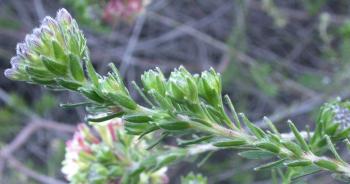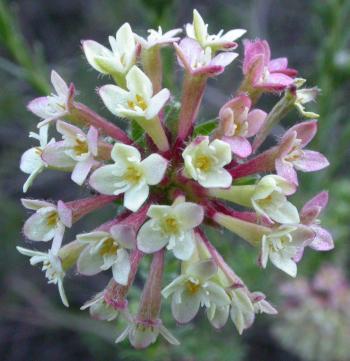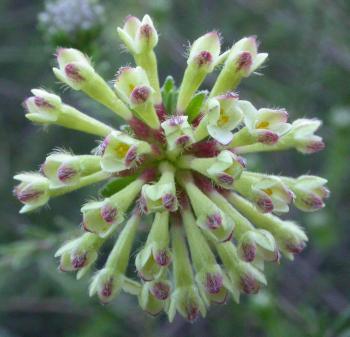Gnidia squarrosa
Gnidia squarrosa (L.) Druce
Family: Thymelaeaceae
Common names: saffron bush (Eng.); aandbossie, juffertjie-roer-by-die nag (Afr.)
Introduction
Gnidia squarrosa has attractive, multicoloured winter-spring flowers that will fill your garden with perfume in the evenings.

Description
Description
Gnidia squarrosa is a much-branched, lax, willowy shrub that reaches a height of 1 to 2 m, with roughly equal spread. The leaves are small and narrowly lance-shaped. The flowers are borne in rounded heads of 6 - 30 flowers at the tips of the slender branches.

The flower consists of a long calyx tube topped by a 4-pointed star, with 8 tiny finger-like petals in the mouth of the tube (which you will only see if you look very closely).

The tubes are mostly greenish yellow, the face of the star is creamy white and the flowers are flushed with maroon-pink, but the degree of pink varies from flowerhead to flowerhead on the same bush. On one end of the scale some heads are almost completely greenish yellow with only a stripe of colour on the back and tip of the stars, while on the other end the base of the tubes are deep maroon and most of the flowers are stained pink, and many are somewhere in between, with only a few of the flowers unevenly stained pink. Overall, they give an attractive multicoloured effect.

The flowers are sweetly fragrant at night but unscented during the day, and adorn the bush in winter to spring (June to October). While not a candidate for the commercial trade, they make a good cutflower, lasting a few days in the vase. The ovary has one locule with one single ovule and the seed is small and enclosed in the persistent base of the calyx.
Conservation Status
Status
According to the Red List of South African Plants, Gnidia squarrosa is assessed as Least Concern (LC).
Distribution and habitat
Distribution description
Gnidia squarrosa is found from the Cape Peninsula to the Eastern Cape and KwaZulu-Natal, where it grows in coastal limestone soils and on sandy slopes.

Derivation of name and historical aspects
History
The genus Gnidia was named by Linnaeus, but it is not clear where it came from or why he chose it. It is perhaps a Greek word for Daphne or laurel, or it is possibly derived from the old Greek name for Knossos in Crete, Knidiossos was one version. Both common names are Afrikaans, aandbossie means 'night or evening-scented bush', and juffertjie-roer-by-die-nag means literally 'young-lady-gad-about-at-night'. Both are generic names given to many plants with night-scented flowers, and the latter name is more strictly used for Struthiola species.
The genus Gnidia occurs in Africa, Madagascar and India, and consists of ± 150 species, most of which occur in tropical and southern Africa. The fibre-bark/gonna family, Thymelaeaceae, is a cosmopolitan family of ± 50 genera and ± 600 species. There are eight genera in southern Africa: Dais, Englerodaphne, Gnidia, Lachnaea, Passerina, Peddiea, Struthiola, and Synaptolepis, and in total there are 192 species in southern Africa. An easy but destructive way to identify members of this family is to peel away a piece of the bark, if it comes off in a long strip then it is very likely Thymelaeaceae.

Ecology
Ecology
The tubular flower, its pale colour and its strong night fragrance indicate that this species is pollinated by moths.
Uses
Use
This gnidia is not recorded as having been put to use, but its relatives are widely used. Many members of this family, mainly Dais cotinifolia and Passerina spp. but also Struthiola spp. and Gnidia spp., are used to make twine and rope. The bark is stripped off and the strips are plaited or twisted together to make a serviceable twine used to tie thatch, bundles of wood and clothing. The common name for the family, gonna, is the original Khoi name for this group of plants that they used to make twine.
Some of the other species of Gnidia are used in traditional medicine; e.g. G. kraussiana is used to treat stomach complaints, scrofula, chest complaints, lumbago, sore throats, snakebite, bile in milk, stomach sores, fractured limbs in stock animals, burns, dropsy, poor appetite, constipation, boils, earache, skin diseases, yellow fever and as a tonic. But many Gnidia species are reported to have severe irritant effects to humans and animals as well as being poisonous to stock. G. kraussiana is reported to have caused the death of a woman who ingested a spoonful of ground roots.
Growing Gnidia squarrosa
Grow
Gnidia squarrosa is an easy plant in the garden, particularly fynbos and coastal gardens. It is also very water-wise when established. It does best in full sun and well-drained soil, and will need some room to spread. Remember to treat it like a fynbos plant, i.e. put it in a well-drained, sunny spot and don't give it manure or heavy doses of chemical fertilizers, and it will thrive. Plant it where you can appreciate its beautiful night scent, e.g. near the house, or beside the patio or a path that you use in the evenings.
Gnidia can be propagated by cuttings. At Kirstenbosch (Trevor Adams, Chief propagator, pers. comm.) we get best results from tip or heel cuttings from semi-mature growth taken in spring. We use a rooting hormone and place them in the mist house with bottom heat of ± 24°C. Rooting takes about 6 weeks and we get a ± 60% success rate. Young soft material, and old woody material does not root readily. Once rooted they are dosed with a seaweed based liquid feed, and hardened off for three weeks and then potted. Once potted they are fed with the liquid feed again and grown for three weeks under shade netting before being exposed to direct sun.
Seed is difficult to harvest because it drops quite soon after it is ripe and is not held in any convenient capsules, and only one seed is produced per flower. As a result, the harvester has to come back frequently and hours of work do not yield much seed. A labour-saving device is to place netting bags over the branches to catch the seed. Seed can be sown in spring, summer or autumn.
References
- Goldblatt, P. & Manning, J. 2000. Cape plants. A conspectus of the Cape flora of South Africa. Strelitzia 9. National Botanical Institute, Pretoria & Missouri Botanical Garden Press, Missouri.
- · Hutchings, A. 1996. Zulu medicinal plants, an inventory. University of Natal Press, Pietermaritzburg.
- Jackson, W.P.U. 1990. Origins and meanings of names of South African plant genera. University of Cape Town Printing Dept., Cape Town.
- Leistner, O.A. (ed.). 2000. Seed plants of southern Africa: families and genera. Strelitzia 10. National Botanical Institute, Pretoria.
- Smith, C.A. 1966. Common names of South African plants. Memoirs of the Botanical Survey of South Africa No. 35. Department of Agricultural Technical Services, Pretoria.
Credits
Alice Notten
Kirstenbosch National Botanical Garden
August 2004
Plant Attributes:
Plant Type: Shrub
SA Distribution: Eastern Cape, Free State, Western Cape
Soil type: Sandy, Loam
Flowering season: Spring, Winter
PH: Acid, Alkaline, Neutral
Flower colour: Pink, Cream, Yellow
Aspect: Full Sun
Gardening skill: Average
Special Features:
Horticultural zones










Rate this article
Article well written and informative
Rate this plant
Is this an interesting plant?
User Comments
Eileen Harvey, Australia
June 23, 2018 at 10:15 AMI learnt a lot from this article. I am a garden guide at the Wittunga Botanic Garden in South Australia where we have several beds of fynbos plants including this one. It grows well in our climate which is similar to Cape Town's. The G. squarrosa plants flower profusely in winter. Eileen Harvey
Login to add your Comment
Back to topNot registered yet? Click here to register.